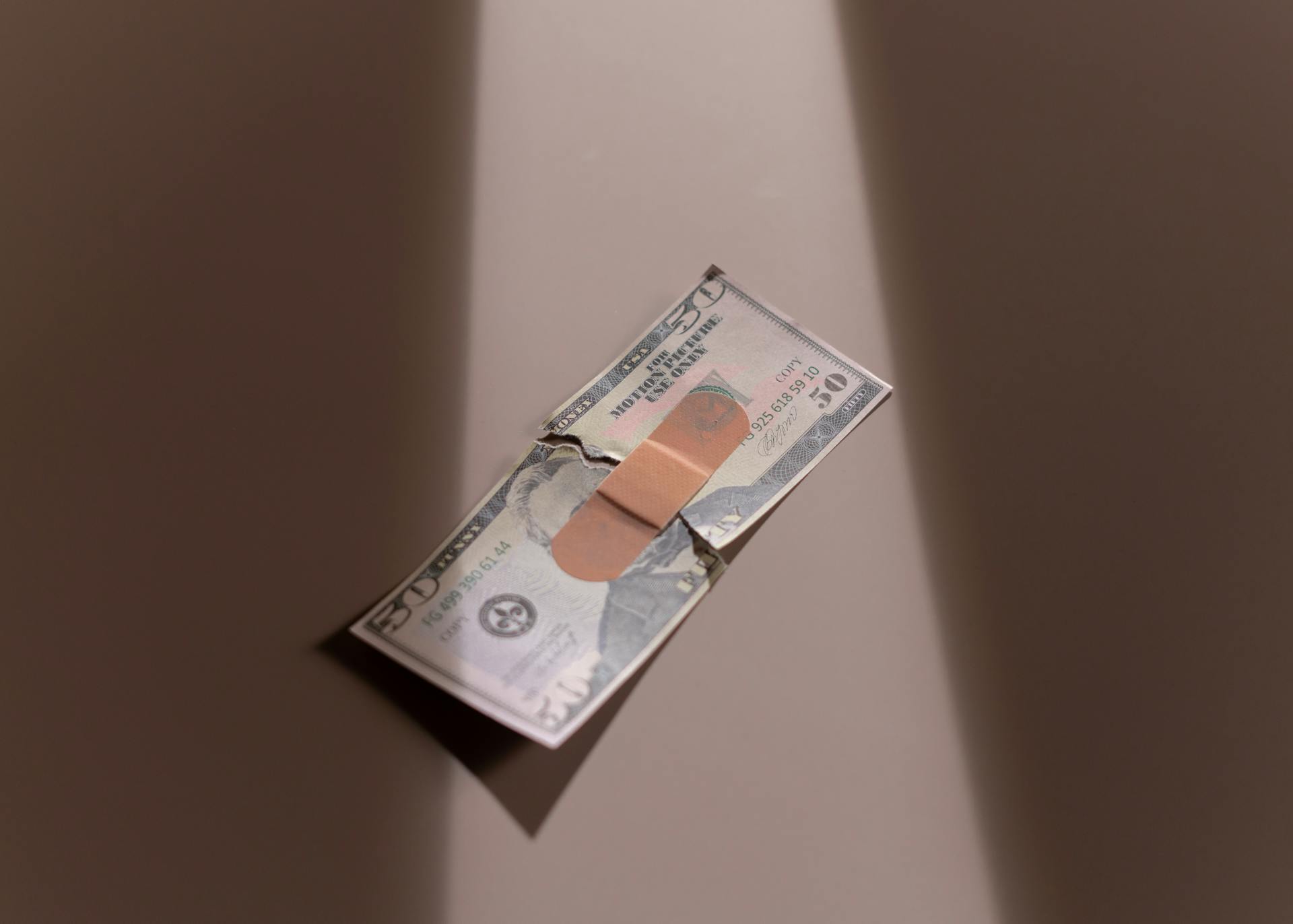
Removing collections from your credit report can be a daunting task, but it's a crucial step in improving your credit score. According to the Fair Credit Reporting Act, you can dispute any errors on your credit report, including collections.
First, you'll need to obtain a copy of your credit report from the three major credit bureaus: Equifax, Experian, and TransUnion. This can be done for free once a year through AnnualCreditReport.com.
Collections can remain on your credit report for up to seven years from the date of the original delinquency, but you may be able to have them removed earlier if you can prove they're inaccurate or uncollectible.
Understanding Collection Accounts
A collection account on your credit report can significantly hurt your chances of getting approved for a loan or credit card. This is because a collection account demonstrates that you couldn't make a payment, which can make you look like a risky borrower in the eyes of creditors.
A large portion of your credit score calculations, roughly 35%, is derived from the consistency of your monthly payments. A collection account on your credit report can make you look like you're not reliable with payments.
A collection account will remain on your credit report for seven years, regardless of whether you've repaid the debt. This means that even if you pay off the debt, the collection account will still be visible on your credit report.
Newer versions of credit scoring algorithms, such as FICO 9 and VantageScore 3.0, do not include paid collections in their calculations. However, FICO 8, one of the most widely used credit scores among lenders, still includes paid collections in its calculations.
Here's a breakdown of how a collection account affects your credit score:
A collection account can be a negative mark on your credit report, but it's not the end of the world. With a solid plan and some effort, you can remove the collection account and improve your credit score.
Removing Collections from Credit Report
Removing collections from your credit report is a crucial step in repairing your credit score. You can start by validating the collection with the company collecting the debt, asking them to provide proof that the debt belongs to you and that they have the legal right to collect it.
To validate the collection, send a letter to the company requesting details about the original creditor, the amount owed, and any relevant documents supporting the validity of the debt. This can help in the removal process.
You can also try to negotiate a goodwill removal with the creditor or collection company. This involves writing a formal letter explaining your request for a goodwill removal and including information about your payment history and financial situation. The creditor may agree to remove the collection from your report as an act of goodwill.
Here's a list of steps to help you remove collections from your credit report:
- Validate the collection by requesting proof from the company collecting the debt.
- Ask the creditor or collection company for a goodwill removal.
- Paying off the debt in collections may be worth it, but it won't improve your credit or remove the collection from your credit report.
- Removing a collection will not erase the debt, and you still owe the debt even if the collection is removed from your credit report.
Statutory Reporting Period
Collections can stay on your report for up to seven years, even if you've improved your financial situation and are making consistent payments.
A collection will remain on your credit report for seven years, regardless of whether you've repaid the debt.
This means that a collection will still be visible to lenders, even if you've paid it off, until it falls off your report after seven years.
You won't see a boost in your credit score even if you pay a collection, as long as it's still reporting on your credit report.
The collection will significantly hurt your chances of getting approved for a loan or credit card, and its effect on your credit score will decrease as it ages on your report.
Removing Collections
Removing collections from your credit report can be a challenging task, but it's not impossible. You can dispute the collection and negotiate with the creditor to remove it, but you'll need to provide proof that the debt is genuine and request a validation letter from the collection agency.
A collections account can stay on your report for up to seven years, even if you've paid the debt. This means that even if you've improved your financial situation and have begun making consistent payments, the collection will still be visible to lenders. Creditors usually send a missed payment to collections once it's been in delinquency for 90 days.
You can try to remove a collection by asking the creditor to delete the original account line and submitting a Universal Data Form to the three major credit reporting agencies. However, this may not work if the creditor or debt collector doesn't have the authority to act for the original creditor.
Paying off a debt in collections may be worth it, but it won't improve your credit or remove the collection from your credit report. You can still be sued for unpaid debt if it's still within the statute of limitations, a period that varies from state to state.
If you're paying off a medical debt, you may be able to get the collection deleted from your credit report once you've paid it. Many collection agencies have recently adopted a policy of deleting medical accounts from credit reports once they're paid. You can ask the collection agency for a deletion, and given the current trends, there's a good chance they'll agree to this request.
Discover more: Can You Freeze All Three Credit Bureaus at Once
To remove a collection, you'll need to follow these steps: ask for proof that the debt is genuine, dispute the collection with the credit bureaus, and negotiate with the creditor to remove it. You can also try sending a goodwill letter to your creditor to remove negative marks, but this usually works better with delinquencies than collections.
Here are some additional tips for removing collections:
- Ask the creditor to delete the original account line and submit a Universal Data Form to the three major credit reporting agencies.
- Request a validation letter from the collection agency to prove the debt is genuine.
- Dispute the collection with the credit bureaus if you can't verify the debt.
- Negotiate with the creditor to remove the collection from your credit report.
- Consider sending a goodwill letter to your creditor to remove negative marks.
Removing a collection can take several months, and it's not a guarantee that the creditor will agree to remove it. However, it's worth trying, especially if you've paid the debt and are looking to improve your credit score.
Monitoring
Monitoring is crucial to confirm that the deletion has been made. It may take up to 30 days for the deletion process to be completed, so keep an eye on your credit report during this period.
Settling debts with collection agencies promptly can be the key to avoiding a negative mark on your credit history.
Verifying and Disputing Collections
Verifying and disputing collections is a crucial step in removing collection debt from your credit report. You should never count on creditors or collection agencies to properly evaluate and state what you owe.
To verify a collection, request a validation letter from the collection agency, which should provide detailed information about the debt, including the original creditor, the amount owed, and any relevant documents supporting the validity of the debt. If they cannot prove it is yours or if there are errors, you can dispute it with the credit bureaus.
A collection account doesn't spell out permanent disaster, and you can try to remove it from your credit report to fix your credit score. Credit bureaus do not report medical debt under $500 and don't report paid medical collections at all.
Here are the steps to take when disputing a collection:
- Request a validation letter from the collection agency.
- Gather all evidence of inaccuracies and submit a credit report dispute to the appropriate credit bureaus.
- Explain to the credit bureaus that the debt is not yours or that there are errors.
Validate the Collection
You need to validate the collection to ensure it's legitimate and not a mistake. A collection agency should provide proof that the debt belongs to you and that they have the right to collect it.
To validate the collection, ask the agency to provide a validation letter with details about the original creditor, the amount owed, and any relevant documents supporting the debt's validity. This letter should be sent to you, not just a generic email or phone call.
A validation letter is essential to verify the debt's authenticity. If the agency can't provide this information, you can dispute the debt with the credit bureaus.
You can request a written confirmation of deletion, but it's not always necessary. Reputable debt collection agencies usually follow through on their promises, even without a formal agreement.
Here's a checklist of what you should ask for in the validation letter:
- Original creditor's name
- Amount owed
- Relevant documents supporting the debt's validity
- Proof that the debt belongs to you
By validating the collection, you can ensure that the debt is legitimate and not a mistake. This is an essential step in disputing the collection and improving your credit score.
Dispute Inaccurate
Consumers should regularly review their credit reports for inaccuracies, not just collections. Mistakes can happen, and catching them early can prevent potential financial complications.
A certified financial planner, Rick Eicheldinger, recommends gathering all evidence of inaccuracies and submitting a credit report dispute to the appropriate credit bureaus.
Credit bureaus are required to investigate your dispute and remove the collection if they can't verify its accuracy within a certain time frame. Lamine Zarrad, CEO of StellarFi, emphasizes the importance of this process.
In some cases, creditors or collection agencies might even label someone else's debt as your own, so it's essential to review your credit reports carefully.
To dispute inaccurate collections, gather evidence and submit a dispute to the credit bureaus. This can help prevent potential financial complications down the road.
Here are the steps to dispute inaccurate collections:
Remember to be honest and paint the bleakest possible picture of your finances when explaining your situation to the original creditor or collection agency.
Requesting Deletion Confirmation
Requesting deletion confirmation can be a crucial step in verifying the removal of collections from your credit report. You should always ask the debt collection agency to confirm in writing that they will delete the account from your credit report.
Most professional debt collection agencies are careful with their communications to avoid legal issues, so they will likely follow through on their promise even without a formal written agreement. However, it's always a good idea to get written confirmation to ensure your protection.
If you do request written confirmation, make sure to assess the reputation and reliability of the agency in question. Not all agencies are created equal, and some may not be trustworthy.
It's worth noting that credit bureaus do not report medical debt under $500 and don't report paid medical collections at all. This means that even if you do pay off a medical debt, it won't necessarily be removed from your credit report.
Here's a simple checklist to help you request deletion confirmation:
- Ask the debt collection agency to confirm in writing that they will delete the account from your credit report.
- Assess the reputation and reliability of the agency in question.
- Check if the debt is medical and under $500, as it may not be reported or removed from your credit report.
Communicating with Collection Agencies
Directly contacting the collection agency is crucial, and can be done via a phone call. This initial communication can be done by contacting the collection agency that holds your account.
To effectively communicate with collection agencies, it's essential to be clear and concise about your intention to resolve the debt. Emphasize your financial situation and the efforts you're making to improve it.
To negotiate a pay-for-delete agreement, start by contacting the company trying to collect the debt and explaining your intention to resolve the debt. Propose a payment plan or settlement offer that you can afford, and make sure to request that they agree to remove the collection from your report once you have fulfilled your payment obligations.
Here are the steps to follow:
- Contact the collection agency directly via a phone call.
- Explain your intention to resolve the debt and emphasize your financial situation.
- Propose a payment plan or settlement offer that you can afford.
- Request that the agency agrees to remove the collection from your report once you have fulfilled your payment obligations.
Remember to get the agreement in writing before making any payments, and double-check your report to ensure that the collection has been removed once you have fulfilled your end of the agreement.
For another approach, see: Difference between Void Agreement and Voidable Contract
Contact the Agency
Contacting the collection agency is a crucial step in resolving the debt and potentially removing the negative entry from your credit report. It's essential to approach this conversation with a clear understanding of your financial situation and the debt in question.
Directly contacting the collection agency is the first step in resolving the debt, as mentioned in Example 5, "Step 1: Contact the Collection Agency." This initial communication can be done via a phone call.
Before making the call, it's a good idea to gather all the necessary information about the debt, including the original amount owed, any interest or fees that have been added, and the current status of the debt. This will help you understand the extent of your financial obligation and give you a starting point for negotiations.
To initiate the conversation, you can propose a pay-for-delete agreement, as suggested in Example 8, "Step 2: Propose a Pay-for-Delete Agreement." This agreement involves paying the debt in full or settling it for a lower amount in exchange for the company removing the negative information from your report.
Here's a summary of the key steps to take when contacting the collection agency:
- Contact the collection agency directly via a phone call.
- Gather all necessary information about the debt.
- Propose a pay-for-delete agreement.
- Clearly state the terms of the agreement before making any payments.
By following these steps, you can effectively communicate with the collection agency and potentially resolve the debt and remove the negative entry from your credit report.
Challenges and Ethical Considerations
Communicating with collection agencies can be a daunting task, but understanding the challenges and ethical considerations can help you navigate the process more effectively.
Major credit bureaus typically discourage pay-for-delete arrangements, as they believe it could undermine the integrity of credit reporting.
The credit system is built on the idea of accurate and complete credit histories, and altering these records for paid debts raises questions about fairness and transparency.
The lack of a standardized approach to pay-for-delete means that outcomes can vary significantly, adding an element of uncertainty for both debtors and creditors.
Not all debts or collection agencies will agree to pay-for-delete, and success often hinges on individual agency policies and the specific circumstances of the debt.
You should understand the limitations of pay-for-delete before trying it, and be aware that not all debts or collection agencies will agree to it.
The absence of a uniform approach to pay-for-delete raises important questions about the fairness and transparency of the credit system.
Here's an interesting read: Questions to Ask Debt Collectors
Frequently Asked Questions
What is the 11 word phrase to stop debt collectors?
To stop debt collectors, use the 11-word phrase: "Please cease and desist all calls and contact with me, immediately
Should I pay off a 5 year old collection?
Pay off a 5-year-old collection if you can, but consider waiting if you're struggling to pay and the statute of limitations is near, as it may help you avoid future legal issues
Sources
- https://www.dovly.com/post/how-to-remove-collections-from-your-credit-report/
- https://consumer.georgia.gov/consumer-topics/debt-collectors
- https://www.businessinsider.com/personal-finance/credit-score/how-to-remove-collections-from-credit-report
- https://www.nolo.com/legal-encyclopedia/getting-debt-collectors-remove-negative-information-from-your-credit-report.html
- https://www.thefaircapital.com/post/pay-for-deletion-in-debt-collection
Featured Images: pexels.com


